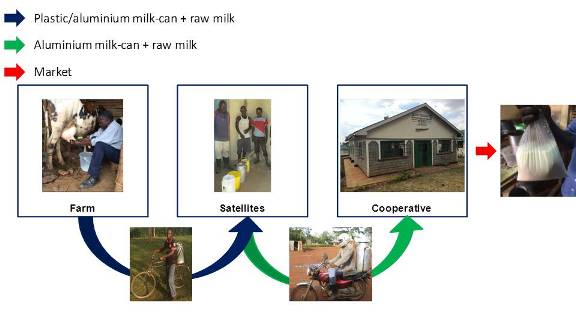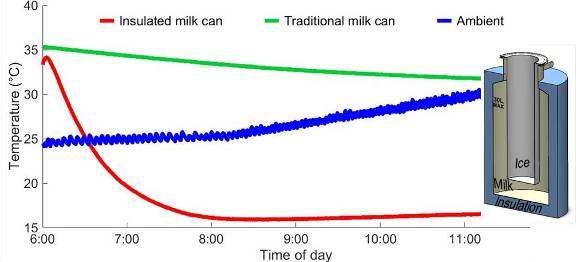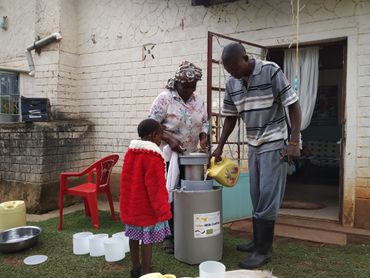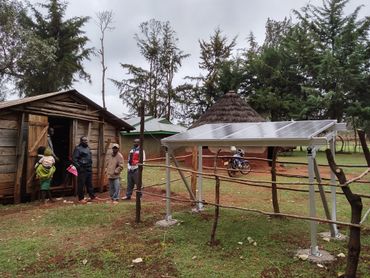Click here to register!
Difference between revisions of "Hohenheim Milk Cooling System - Implementation in Kenya"
***** (***** | *****) |
***** (***** | *****) |
||
| (4 intermediate revisions by 2 users not shown) | |||
| Line 1: | Line 1: | ||
| − | [[Solar_Milk_Cooling_with_Insulated_Milk_Cans|- | + | |
| + | |||
| + | [[Solar_Milk_Cooling_with_Insulated_Milk_Cans|Back to: Solar Milk Cooling with Insulated Milk Cans]]<br/> | ||
| + | |||
| + | [[Do_It_Yourself_-_Solar_Cooling_Units|Back to: Do It Yourself - Solar Cooling Unit]]<br/> | ||
= Introduction = | = Introduction = | ||
| Line 13: | Line 17: | ||
This research aims the development of dairy value chains in an integrated approach to improve productivity and reduce losses along the value chain. | This research aims the development of dairy value chains in an integrated approach to improve productivity and reduce losses along the value chain. | ||
| − | |||
| − | |||
| − | |||
| − | |||
<br/> | <br/> | ||
| Line 74: | Line 74: | ||
[[File:Installed panels to run the refrigerator.jpg|thumb|right|370px|The installed panels to power the refrigeration unit.]] | [[File:Installed panels to run the refrigerator.jpg|thumb|right|370px|The installed panels to power the refrigeration unit.]] | ||
| + | |||
| + | [[Category:Powering_Agriculture]] | ||
| + | [[Category:Solar]] | ||
| + | [[Category:Kenya]] | ||
Latest revision as of 16:48, 14 December 2018
Back to: Solar Milk Cooling with Insulated Milk Cans
Back to: Do It Yourself - Solar Cooling Unit
Introduction
Smallholder dairy farms are the major providers of marketed milk in Kenya, becoming even stronger when associating in cooperatives. These groups are mostly constrained by a lack of cooling systems, reduced hygienic conditions, minimum cleaning procedures and in some cases problems with cattle health, which results in high microbial contamination.
Under warm climatic conditions, raw milk can exceed the maximum bacterial count after two to five hours without cooling resulting in a lack of quality and leading to high rates of rejected milk at the different stages of collection. Therefore, drawing on the experience of a successful research project in Tunisia, the solar milk cooling group is testing solar-based cooling systems that can be operated independently offering an off grid solution for remote areas in Kenya.
This research aims the development of dairy value chains in an integrated approach to improve productivity and reduce losses along the value chain.
Siaya county
January 2016 until December 2017:
The work is supported by the Program of Accompanying Research for Agricultural Innovation – PARI and GIZ initiatives in Kenya (Powering Agriculture-PA and Green Innovation Centres – GIC).
The success for the implementation of this innovative technology relies on the plastic insulated milk can. As a first stage of the introduction of the technology, measurements on milk temperature during transport were collected from milking to the moment of retailing at SAM Malanga dairy cooperative society in Siaya county (located at 0.06 N, 34.29 E). The target was the establishment of the state of the art in the region. Milk temperature profiles were genertated over the transport time to the cooperative, by performing this procedure, a low milk quality could be expected.
Base on this initial information, milk temperature profile was evaluated in the insulated milk can and compared with a traditional milk can (aluminum milk can) following the protocol for the stainless steel insulated milk can for Tunisia.
The evaluation was performed in collaboration with PA, GIC, Jaramogi Oginga Odinga University of Science and Technology (JOOUST), SAM Malanga dairy cooperative society. The first stage of this research was covering the installation and monitoring of the system at the cooperative. Further research will focus in the evaluation of the system in early stages of milk handling (satellites and farm).
Bungoma & Kakamega county
January 2018 until April 2018:
Piloting business models for solar milk cooling in Kenya:
The overall goal of the presented project is to identify, assess and promote business models that would contribute towards an up-scaling of the ice-based milk cooling concept in Kenya.
In relation to the promising acceptance of the introduced milk-cooling systems in Kisumu, Kenya, the presented project shall focus on the financial and economic assessment of business opportunities as main indicator for future interventions as further development of the technology, its promotion and cooperation with companies for its local production and commercialization. The objectives include:
- The financial and economic estimation of income generation potential of the current key beneficiaries involved in the project PARI within the actual pilot testing of 2-4 systems in Siaya and other suitable locations.
- To identify and formulate suitable business models and mentor beneficiaries on how to implement and manage a selected business model.
- The elaboration of strategies to promote and introduce small-scale milk cooling systems at different levels of the dairy value chain (farm, collecting points, cooperative, dairy plants) to give the Bayerischen Landfrauen initiative recommendations on how and where to effectively introduce the 2 systems planned.
- The study of the state of the art of local industry for a sustainable commercialization and maintenance of the studied milk cooling solution.
























